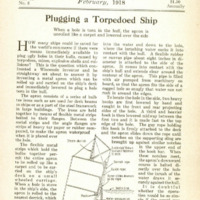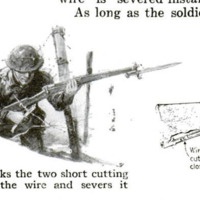Wire cutter attached to gun
Item
-
Title (Dublin Core)
-
Wire cutter attached to gun
-
Article Title and/or Image Caption (Dublin Core)
-
Wire Cutter Attached to Gun
-
Caption: The soldier backs the two short cutting blades against the wire and severs it
-
extracted text (Extract Text)
-
WHEN the
hail of
shells upon the
enemy’s entan-
glements doesnot
destroy them en-
tirely, the soldier
himself must
complete the job.
Hence it is that,
along with a score
of other instru-
ments Initiated in the
present war, the wire
cutter takes its place
as part of the modern
soldier's equipment.
While these new in-
struments are necessary, they are never-
theless a great encumbrance. A step in
the direction of minimizing the unwieldi-
ness of a number of separate instruments
has been taken by Frederick A. Warner,
of Halifax, Nova Scotia. The bulky pair
of shears has been converted into a simple
lever, attached to the soldier's gun in a *
groove underneath the stock. The hinged
end of the lever, which lies towards the
forward part of the stock, is pivoted be-
tween two short cutting blades. When a
piece of wire is placed across the blades
and the lever is swung inwards, the barbed
wire is severed instantly.
As long as the soldier is in action, he
As long as the soldier is in action, he
keeps his gun
steadily pointed
I] . at the enemy.
When he comes to an entanglement, all
that he has to do is to back the blades
against the barbed wire in order to sever
it. Between cuts, the solCier keeps up
his fire upon the resisting trenches,
when in a position to aim with any de-
gree of accuracy.
-
Contributor (Dublin Core)
-
Frederick A. Warner (inventor)
-
Language (Dublin Core)
-
eng
-
Date Issued (Dublin Core)
-
1918-02
-
pages (Bibliographic Ontology)
-
202
-
Rights (Dublin Core)
-
Public Domain (Google digitized)
-
Archived by (Dublin Core)
-
Filippo Valle
-
Alberto Bordignon (Supervisor)
 Popular Science Monthly, v. 92, n. 2, 1918
Popular Science Monthly, v. 92, n. 2, 1918



